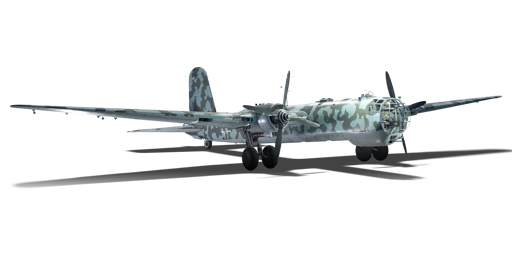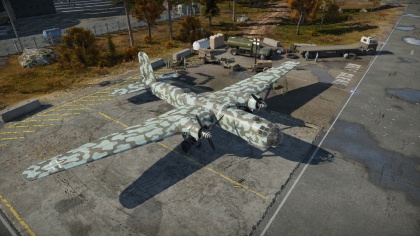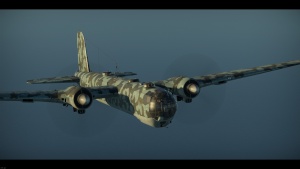Difference between revisions of "He 177 A-5"
m (→Description) (Tag: Visual edit) |
ChristianRG (talk | contribs) m (→Pros and cons) (Tag: Visual edit) |
||
| Line 276: | Line 276: | ||
* Engines oil cooler and flaps are vulnerable against machine guns fire | * Engines oil cooler and flaps are vulnerable against machine guns fire | ||
* Incapable of flying with one engine only, will keep losing altitude and eventually will have to land or crash | * Incapable of flying with one engine only, will keep losing altitude and eventually will have to land or crash | ||
| + | * Incredibly expensive repair cost, 50,000+ SL in RB when fully upgraded | ||
== History == | == History == | ||
Revision as of 02:59, 12 October 2020
Contents
Description
The He 177 A-5 Greif is a rank IV German heavy bomber
with a battle rating of 6.3 (AB/SB) and 6.0 (RB). This bomber was introduced in Update 1.77 "Advancing Storm" as part of the revenue share program. It was created by Daniil "Joy_Division__" Zaytsev.
The Heinkel He 177 A-5 is a heavy bomber that excels at destroying stationary targets such as pillboxes and bases from altitude. Its speed allows to bomb one base or two before confronting any enemy plane and then withdrawing back in shallow dive. Even if an enemy is trying to intercept you, your defensive armament in manual mode would keep it at bay.
General info
Flight Performance
| Characteristics | |||||||
|---|---|---|---|---|---|---|---|
| Stock | |||||||
| Max Speed (km/h at 6,500 m) |
Max altitude (meters) |
Turn time (seconds) |
Rate of climb (meters/second) |
Take-off run (meters) | |||
| AB | RB | AB | RB | AB | RB | ||
| 531 | 518 | 10000 | 32.2 | 33.4 | 5.9 | 5.9 | 1,600 |
| Upgraded | |||||||
| Max Speed (km/h at 6,500 m) |
Max altitude (meters) | Turn time (seconds) | Rate of climb (meters/second) |
Take-off run (meters) | |||
| AB | RB | AB | RB | AB | RB | ||
| 582 | 555 | 10000 | 29.8 | 31.0 | 10.5 | 8.0 | 1,600 |
Details
| Features | ||||
|---|---|---|---|---|
| Combat flap | Take-off flap | Landing flap | Air brakes | Arrestor gear |
| ✓ | ✓ | ✓ | X | X |
| Limits | ||||
|---|---|---|---|---|
| Wing-break speed (km/h) |
Gear limit (km/h) |
Combat flap (km/h) |
Max Static G | |
| + | - | |||
| 0 | 260 | 450 | ~?? | ~? |
| Optimal velocities | |||
|---|---|---|---|
| Ailerons (km/h) |
Rudder (km/h) |
Elevators (km/h) |
Radiator (km/h) |
| < 300 | < 310 | < 360 | > 715 |
| Compressor (RB/SB) | ||
|---|---|---|
| Setting 1 | ||
| Optimal altitude | 100% Engine power | WEP Engine power |
| 5,700 m | 2,520 hp | 2,797 hp |
Survivability and armour
- 9 mm Steel plates in pilot’s seat.
- 7 mm Steel plate under the entire cockpit
- 9 mm Steel plate in front of the front dorsal gunner.
- 7 mm Steel plates on cockpit roof around front dorsal gunner.
- 7 mm Steel plates around rear dorsal gunner.
- 7 mm Steel box in front of the rear dorsal gunner.
- 57 mm Bulletproof glass in front of tail gunner.
- 9 mm Steel plates around the bottom and front of tail gunner.
Armaments
Suspended armament
The He 177 A-5 can be outfitted with the following ordinance:
- 48 x 50 kg SC50JA bombs (2,400 kg total)
- 12 x 250 kg SC250JA bombs (3,000 kg total)
- 6 x 500 kg SC500K bombs (3,000 kg total)
- 4 x 1,000 kg SC1000L2 bombs (4,000 kg total)
- 2 x 1,800 kg SC1800B bombs (3,600 kg total)
- 2 x 1,800 kg SC1800B bombs + 6 x 500 kg SC500K bombs (6,600 kg total)
- 3 x 1,400 kg PC 1400 X (Fritz X) bombs (4,200 kg total)
Defensive armament
The He 177 A-5 can defend itself with:
- 1 x 20 mm MG 151 cannon, chin turret (300 rpg)
- 1 x 20 mm MG 151 cannon, tail turret (800 rpg)
- 2 x 13 mm MG 131 machine gun, front dorsal turret (1,000 rpg = 2,000 rpg)
- 1 x 13 mm MG 131 machine gun, rear dorsal turret (1,000 rpg)
- 1 x 13 mm MG 131 machine gun, ventral turret (1,000 rpg)
- 1 x 7.92 mm MG 81 machine gun, nose turret (1,000 rpg)
Usage in battles
Combining the speed and handling of the Do 217 and the immense payload of the Lancaster along with defensive armament approaching that of the American bombers, the He 177 Greif is an outstanding heavy bomber. Its max payload of 2 x 1,800 kg and 6 x 500 kg bombs is easily the best of its contemporaries when it comes to demolishing bases in AB and airfields in RB/SB. Other payloads are quite useful depending on the bombing objectives in RB/SB: 6 x 500 kg against bases (3 per bases), 4 x 1000 kg and 2 x 1800 kg for aircraft carriers and airfields.
The He 177 bears some similarities to the Do 217 series. It has an exceptionally high dive speed for a heavy bomber and is capable of reaching up to 700 km/h in a dive. It is, however, more manoeuvrable at high speeds, one has to be careful not to overload the wings. The two engines (which are really two V12 DB 605 engines coupled together to drive one four-bladed propeller, making them essentially 24 cylinder engines) are very powerful, but at the same time more vulnerable to damage.
The defensive armament of the Greif is very good by German standards, consisting primarily of 13 mm MG 131 heavy machine guns, completed with 2 MG 151/20 cannons, one in front and one in tail turret. The large tail fin prevents the dorsal turrets from firing directly to the rear, leaving only the MG 151/20, however.
Climbing and bombing
The He 177 A-5 will spawn at 4.5 km as a long-range bomber and as such, it's much easier to get out the reach of interceptors. Do some side climbing, reach 5,000 m after game start (speed will decrease to 250 km/h, but still fine) and continue with a 5-degree climb. Remember, this aircraft is not a dive bomber and should not be treated as such.
In order to do side climbing, you should upgrade the engine parts and then, just go ASAP to the ETC 1000/I module. After this upgrade, you will be able to carry 4 x 1,000 kg bombs which can be used to destroy up to 4 bases (no external wing carried bombs here).
After upgrading engine parts and getting ETC 1000/I, it's time to climb and boom! Just go for the nearest base after reaching +6,000 m altitude. Then, it's done. Be careful of enemy interceptors which may snake their way up to your altitude, because you are really vulnerable at low speeds, hence the recommendation to side-climb. Side-climbing will help pilot have enough time to reach high altitudes, and lay in a bombing run.
Some notes:
- You should use combat flaps when bombing airfield to decrease speed (there's a chance of not hitting the airfield)
- Protect your aircraft as the repair costs are 40,000 Silver Lions.
- Losing one flap will cause instability, just be careful!
Manual Engine Control
| MEC elements | ||||||
|---|---|---|---|---|---|---|
| Mixer | Pitch | Radiator | Supercharger | Turbocharger | ||
| Oil | Water | Type | ||||
| Not controllable | Controllable | Controllable | Controllable | Separate | Not ontrollable | Not controllable |
Modules
| Tier | Flight performance | Survivability | Weaponry | |||
|---|---|---|---|---|---|---|
| I | Fuselage Repair | Radiator | Turret 7 mm | ETC 250/IV | Turret 20 mm | |
| II | Compressor | Airframe | New 7 mm MGs (turret) | ETC 500/II | ||
| III | Wing Repair | Engines | Turret 13 mm | ETC 1000/I | New 20 mm cannons (turret) | |
| IV | Engine Injection | Cover | New 13 mm MGs (turret) | ETC 1800 | FX 1400 | |
Pros and cons
Pros:
- Heavy defensive weaponry with accurate 13 mm and 20 mm turrets
- Plenty of bomb load options, with a maximum bomb load of four 1,000 kg bombs
- Can carry all 4 x 1,000kg SC1000L2 bombs in the bomb bay, so He 177 A-5 can get 3-4 bases at first spawn in realistic battles
- One of only three heavy bombers for Germany, and the only high-rank heavy bomber in the tech tree
- Capable of speeds of up to 530 km/h or 340 mph in level flight
- First spawn at long-range bombers' altitude, which will help get altitude over interceptors and other fighters
- Good climb rate, can easily make it to 6.5 km altitude
- Dual engine aerodynamic, make it quite manoeuvrable for a heavy bomber
- Combat flaps are really useful for decreasing airspeed
- Fritz X guided bomb is very effective against destroyers and other slow-moving ships (drop from +2,000 m)
- High SL multiplier, very good money making
Cons:
- Plane is vulnerable in frontal engagement due to the absence of copilot and the glazed nose
- Engines overheat very quickly when activating WEP and when the cooling system is empty
- Vulnerable from side attacks
- Expensive repair cost for RB and higher than average on AB and SB
- No air brakes for a heavy bomber which increases landing difficulty
- Being a heavy bomber means that you can't take off from medium airfields
- Quickly overheats above 5,500 m
- Engines oil cooler and flaps are vulnerable against machine guns fire
- Incapable of flying with one engine only, will keep losing altitude and eventually will have to land or crash
- Incredibly expensive repair cost, 50,000+ SL in RB when fully upgraded
History
Development of the He 177 began in 1936 as part of the Bomber A specifications issued by the German Air Ministry (RLM). The specifications called for a long-range, high-speed bomber with a payload of 1,000 kg. Despite the very demanding specifications, Heinkel began working on a mockup which was submitted for review in late 1937, with an order for 12 experimental machines following shortly after in early 1939. However, throughout its development, the He 177 suffered from a range of problems, some of which weren’t even fixed before further development stopped. For example, one of the requirements (which was soon rejected, since it was impossible to implement) from the Air Ministry was the ability to bomb from a dive, that’s why the engineers had to make various workarounds to provide the required flight technical characteristics. To reduce aerodynamic drag and to ensure flight range, two DB 601 engines were installed in pairs on one gondola and worked with a common shaft which rotated one four-bladed propeller. Thanks to this it was possible to create the aircraft using a two-engined scheme. But for this reason, the vehicle suffered from severe engine overheating issues and more often than not experienced mid-flight engine failures and frequent fires. In the process of fine-tuning the aircraft, the weight was significantly increased, so it became necessary to install a massive frame which could not be hidden - a relatively thin wing or tightly packed nacelles wouldn't fit. As a result, each frame was divided into two racks, each with a single wheel that could be retracted into the wing on opposite sides of the nacelle.
By 1944, development of the He 177 was considered finished, but by that time, the fortune of war had already turned on Germany and the need for a complex strategic bomber had faded. Nonetheless, over 1,000 He 177s were produced across several variants, with most machines seeing action on the Eastern front. However, despite being made in large numbers, the aircraft ultimately failed to make a difference in the war’s outcome as its design maturity came too late, although some of the built vehicles were also used after war’s end.
- From Devblog
Media
See also
Links to the articles on the War Thunder Wiki that you think will be useful for the reader, for example:
- reference to the series of the aircraft;
- links to approximate analogues of other nations and research trees.
External links
| Heinkel Aircraft Company (Heinkel Flugzeugwerke) | |
|---|---|
| Fighters | He 51 A-1 · He 51 B-1 · He 51 B-2/H · He 51 C-1 · He 51 C-1/L |
| He 100 D-1 | |
| He 112 A-0 · He 112 B-0 · He 112 V-5 | |
| Jet fighters | He 162 A-1 · He 162 A-2 |
| Twin-engine fighters | He 219 A-7 |
| Bombers | He 111 H-3 · He 111 H-6 · He 111 H-16 |
| He 115 C-1 | |
| He 177 A-3 · He 177 A-5 | |
| Export | He 112 B-1/U2(Hungary) · He 112 B-1/U2(Romania) · He 112 B-2/U2 · A7He1 |
| T 2 | |
| Germany bombers | |
|---|---|
| Arado | Ar 196 A-3 |
| Blohm & Voss | BV 138 C-1 · BV 238 |
| Dornier | Do 17 E-1 · Do 17 Z-2 · Do 217 E-2 · Do 217 E-4 · Do 217 K-1 · Do 217 M-1 |
| Focke-Wulf | Fw 189 A-1 · Fw 200 C-1 |
| Henschel | Hs 123 A-1 |
| Heinkel | He 111 H-3 · He 111 H-6 · He 111 H-16 · He 115 C-1 · He 177 A-3 · He 177 A-5 |
| Junkers | Ju 87 B-2 · Ju 87 R-2 · Ju 87 R-2 Libya · Ju 87 D-3 · Ju 87 D-5 · Ju 88 A-1 · Ju 88 A-4 · Ju 188 A-2 · Ju 288 C |
| Messerschmitt | Me 264 |
| Savoia-Marchetti | ▀S.M.79 serie 1 · ▀S.M.79 B · ▀S.M.79 serie 4 · ▀S.M.79 serie 8 |
| ▀S.M.79 AS · ▀S.M.79 bis/N · ▀S.M.79 bis/T.M | |
| Trophies | ▀Wellington Mk Ic |






